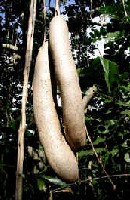View crop
View crop Data sheet EcoPortKigelia pinnata
 |
|
| Notes |
|---|
| DESCRIPTION: It is a medium to large tree, up to 25 m in height, with a dense rounded crown; bark grey, generally smooth in large specimens, flaking in thin, round patches. Leaves opposite, crowded near the ends of branches, compound, with 3-5 pairs of leaflets plus a terminal leaflet; leaflets oblong, up to 6 x 10 cm, leathery. Flowers striking, dark maroon with heavy yellow veining on the outside. Fruit very unusual, sausage shaped, up to 1 m x 18 cm, greyish-brown. USE: In times of food shortage, the seeds are roasted in hot ashes and eaten. Raw fruit are poisonous to humans. Flowers and leaves can be used as fodder. The flowers are sought by bees. The wood is easy to work and produces a good-quality timber for general use. A black dye can be produced from the fruit. Tannin can be extracted from the roots and stem bark. Bark, leaves and fruit have medicinal properties. It can be used for riverbank stabilization and as an ornamental, though it should be taken into consideration that dropping fruits may weigh up to 12 kg. GROWING PERIOD: Perennial. COMMON NAMES: sausage tree. FURTHER INF: The tree is widespread in Africa, found primarily in wet savannah woodland spreading into gallery woodland and along rivers in moist forests. In open woodland and in riverine fringes. It is not frost resistant, but if young plants are protected for the 1st 2-3 years from cold winds in colder areas, they will survive. |
Sources |
| SOURCE: ICRAF Agroforestree Database |